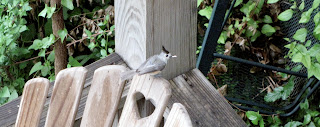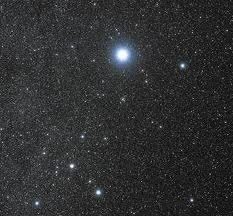Our neighbor's metal roof looks way too hot for a perch, but this Black-crowned Night Heron doesn't seem to mind. He perched there this morning, resting lazily on one foot, as the sun crept higher and higher, hotter and hotter, in the late July sky. Taken through the window that overlooks the Arroyo, this photo of the night heron is one of the few I've snapped lately. It's just too hot to wander around the yard. If I go out early, camera in hand, the lens fogs up. If I wait a while, the heat is stifling, the humidity is oppressive, and the mosquitoes are unbearable.
Looking out the window from an air conditioned house, though, the weather is just fine. I've arranged furniture so that the most comfy seats face the views of the river and the bank beyond. Binoculars and scope are within reach. A rocking chair sits right next to one of the two six-by-six windows. From it I can peer down on feeders and baths and the butterfly garden.
Six tiny Black-crested Titmice (maybe the family that lived in the cow-skull nest cavity?) and three Carolina Wrens twitter in the Live Oak tree outside the window. Energetic and active, they flitter among leaves lit by the the sun, making me feel especially lazy and lethargic by contrast. If I step out on the porch, I can hear a Chachalaca chorus, reminding me always of summer days, and two Inca Doves calling whirlpool! whirlpool! from opposite sides of the Arroyo. (If I step outside on the porch, I remember the heat and return to my rocking chair!)
 No wonder July has passed without my posting to my blog since the first day of the month--I have scarcely moved from the rocking chair!
No wonder July has passed without my posting to my blog since the first day of the month--I have scarcely moved from the rocking chair!These are indeed the Dog Days of Summer, those days so long and languorous.
The ancient Greeks called these long hot summer days "Dog Days," because that was when Sirius, the "Dog Star," rose in the sky each day just as the sun rose. Of course, we can't see Sirius presiding over the hours after sunrise, but the ancients felt the dog star influenced the days from July through August, bringing the scorching weather.
Sirius, the brightest star we see in the sky (other than the sun), is part of one of the few constellations I can actually identify: Canis Majoris, the Big Dog. It's near (well, in relative terms) my favorite constellation, the hunter Orion whose three aligned stars form a very recognizable "belt." Canis Major is the group of stars that the belt of Orion seems to "point" to. The photo at left above (not taken by me, borrowed from the the internet) is of Canis Majoris. Can you see a dog there? I really can't either (the ancients had a better imagination, I guess) but I can certainly see Sirius. In the winter months, the dog constellations (there's also a Little Dog hunting with Orion) will be in the night sky and can be seen easily.

Dog Days have arrived at the Arroyo Colorado in more than one way: we've just adopted two canis minor of our own. Rescued from puppy mills in Missouri and Arkansas, they needed a good home -- so we brought them home to Texas a couple of weeks ago. We think they are perfectly adorable.
That's where our July has gone, to the dogs!
Really, we've been out of town for at least half of the month. We visited our Missouri granddaughters who turned seven years old early in the month. Then our five Texas grandchildren came here for a visit. The three boys spent lots of time fishing. The girls, their mother, and I stayed inside, trying to stay cool.
The river was still quite muddy from upriver flooding caused by the hurricane rains in Mexico, so fishing from the dock was not successful. But they caught lots of redfish in the bay. Here's the group leaving from our dock early one morning. Notice how high the water is--no walking space for herons and egrets along the banks--and how green the unusually large amount of moisture has caused the bankside to be.
Here's a very happy fisherman with his grandpop. Mitchell is the youngest of the three boys, but on this trip he was the champion fisherman. This is the smallest of the redfish he caught out in the bay.
The guys had a great time fishing in the Laguna Madre where water was deep (four feet is deep for the bay!) but relatively clear. One day they caught 172.5 inches of reds and a couple of small trout as well!
At high tide, wakes from boats splashed water over the dock or pushed it up from below so that it looked like the fountains of Bellagio! Four weeks after the hurricane, we are still feeling its effects as flood water drains from a dam far upriver on the Rio Grande.
Here the fishermen jump over the fountains of water pushed up from beneath the dock. Water is still being released from Falcon dam on the Rio Grande, and as it makes its way to us (the arroyo is a floodway of the Rio Grande) it is very muddy and filled with debris--but fun for boys on vacation at Grammy and Papa's house.
A birding highlight was a Great Horned Owl that flew from a palm tree at dusk after Grammy called "hoo hoo hu hoo." (A favorite children's book of my grandchildren is Jane Yolen's Owl Moon in which a child goes "owling" at night with his dad.) During the day Green Jays and Cardinals brightened the window feeders. Out in the bay Roseate Spoonbills and Reddish Egrets winged their way from rookeries to feeding flats and back to rookeries again.
 An eating highlight was Pirate's Landing in Port Isabel, with windows that overlook the causeway to South Padre Island. Sadie and her siblings looked jaunty in their pirate hats. Caleb, Spencer, and Mitchell ate fish that was good, but not as good as the redfish their dad would cook for them later, a delicious reminder of a great fishing day.
An eating highlight was Pirate's Landing in Port Isabel, with windows that overlook the causeway to South Padre Island. Sadie and her siblings looked jaunty in their pirate hats. Caleb, Spencer, and Mitchell ate fish that was good, but not as good as the redfish their dad would cook for them later, a delicious reminder of a great fishing day. We always have a great time with our family, but this visit may have been the best ever.
Dog Days of summer on the Arroyo Colorado are days to remember.
Or to dream about for the rest of the year.













